Mediamax has talked to sculptor Mikael Ohanjanian, one of the 18 artists representing the Armenian pavilion at 56th Venice Biennale. The sculptor presented his work “Twelve” at Armenity pavilion, which won the grand prize – the Golden Lion.
-“Twelve” sculpture has been reflection of material power, yet at the same time of subtleness and contrast.
“Twelve” is comprised of 12 sculptures with around 12 meters in diameter. It’s a symbolic number for me. This work stands for Armenity. I tried to depict the feeling I have had since childhood. It’s a spatial rhythm, a vibration I feel only here in Armenia. Karahunj inspired me to carve “Twelve.”
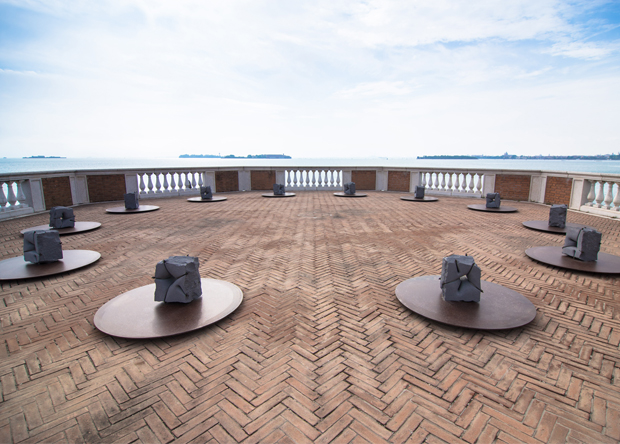 Mikael Ohanjanian's "Twelve" sculpture
Mikael Ohanjanian's "Twelve" sculpturePhoto: Piero Demo
The holes in those stones stand for windows or gates through which I can look to the new. There are various scientific approaches regarding those stones and holes, but I believe it’s not by chance. A look at the sky at a younger age brings forth the desire to see a different reality there, to dream and aspire for new things.
I had the inner wish to emphasize the will and desire to look to the new at this exhibition dedicated to the centenary of the Armenian Genocide. The fact we still exist and are able to create is already a power of will and it’s the direction towards which we should work on.

- What did you gain from the 56th Venice Biennale?
- Our pavilion was the result of a wonderful work. Both the theme and the artists were selected properly. Our national pavilion used to receive quite active responses even before we were awarded the Grand prize. I hope the success here will serve an impetus to increase the attention of Armenia’s public and private sector to our contemporary art.
- You spoke about drawing the attention of the public and private sector. Are you aware of the cultural initiative carried out by IDeA and RVVZ Foundations – Dilijan Art Initiative?
- Along with Co-Founder of the Foundations Veronika Zonabend I had the chance to visit UWC Dilijan College, which is built in very professional way and is an extremely important element in the education system. I believe this College will enliven our education system, and I hope I myself will be involved in that cultural process. I would be happy to cooperate and work together with them.
- You were 21 when you first presented your work to wider public abroad. What responses did you receive and how do people around the world accept Armenian culture today?
- It was in 1998 when I participated in an art biennale with several established and famous sculptors from Armenia. I was the youngest participant in the history of that biennale and I won the first prize. It was highly important for me and it encouraged me to leave for Italy to study.
 Mikael Ohanjanian
Mikael Ohanjanian
As back then, so today, the Armenian culture receives warm responses. We are a nation that possesses an identity and a mindset. The problem is that we often focus on the past. The past is undoubtedly very important, but focusing on it we forget to do what we should do today. We should look to the future, while we don’t, and if there are some people doing it, they constitute a very small portion. If we don’t do anything today, we will face various issues tomorrow.
There are many good artists but I believe we should reconsider our views and promote that way of thinking on state level as well.
-15 years ago you moved to Italy to enrich your professional knowledge. I know you often visit Armenia. If compared, how does art that has to do with space and scale progress in the two countries?
- I often think about this issue. Armenia seriously considers the space; there is urban planning and there is architecture. Everything develops but the problem is the way it all is carried out. In my opinion, Armenia still has the way of thinking it inherited from the Soviet period. We need time. Exchange of practice is very important. Besides, we should be open and willing to accept novelties. It is not always easy as there is the fear of making the weak aspects visible. I am inclined to think that the mindset and the upbringing weigh heavier in this regard.
- Bringing forth the issues makes it possible to rectify them and develop, doesn’t it?
- Exactly! It’s something mandatory. The society changes for reasons that are known, thus, naturally, whatever happened in the past cannot comply with the new processes. We should importantly understand the new situation and finding our values and reality become consonant with the new requirements. It’s the only way to develop; otherwise we have a reality, which attempts to preserve the traditional, which does not meet the present reality. At the same time, our key identity seems to be forgotten and ignored.
- What evolution have your works undergone? How did the predilection for carving the “invisible” spring up?
- During my study years, a slight “segregation” emerged between my outlook on the scale of the sculpture and the technical and professional solutions.
This process of segregation became more emphasized when I got acquainted with the history of modern art in Florence, and in 2007 I realized that what I do and what I feel do not “intersect.” It was a thought-out and beautiful work but it had nothing to do with the reality and my feelings. A wish to refract that moment occurred in me and I decided to depict the sculpture from the inside and not the outside.
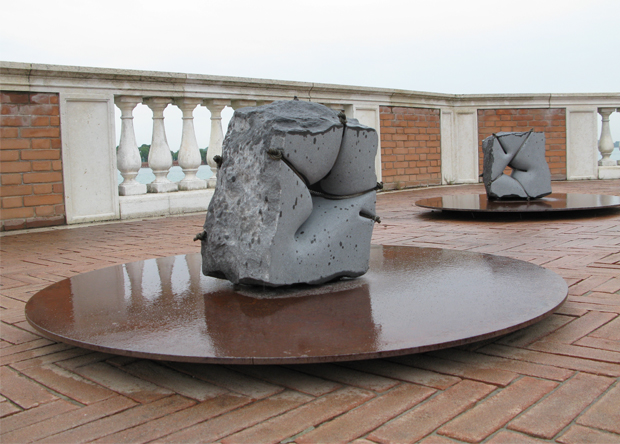 Mikael Ohanjanian's "Twelve" sculpture
Mikael Ohanjanian's "Twelve" sculpturePhoto: from M.Ohanjanyan's archive
It was a result of mental analysis, a mere wish to study the human and understand what lies there below the surface. In 2011 I had this wish to nullify the entire path I had passed. I used to take the cube and express everything I felt through it.
Then the “Prospettiva Introversa” (“Introspective Prospects”) was conceived, which combined the strained or relaxed ties between the inner and the outer – I was trying to study from all aspects. At the 2nd Premio Henraux International Competition of Sculptures in 2014, I presented a work depicting the empty space of one of my previous works. I just had the wish to depict the emptiness. I don’t think the empty space is something nonexistent. There are various realities, which can be both material and non-material.
- Mikael, you made quite great strides over these years. Which is your key to success?
- It is curiosity. Such events are not just a chance to participate in competitions; they grant me an opportunity to study the reality that revolves around me. It seems to be a journey, which enriches me. I do my best to learn as much as I can. Unlike the education process of the previous years when the composition was being created around the thought and the invention, the sculpture is now called into being from the idea, which is being a subject to a detailed analysis. It’s a personal, social and psychological process, which blends in me.
The work is born after having passed a long way and being “flavored” with information. That is my secret. The work born as a result of all this is the reality that passed through me having been “cooked” in my inner oven.
I don’t ply my audience with a certain reality; I engage them in it – I create a space, a psychological state in which they start asking questions themselves. I don’t try to give them answers; it’s something each of them should find based on their cultural basis and aspirations.
- What peculiarities does contemporary sculpture have?
-I have observed some negative attitude to contemporary art in Armenia. The same is in Italy. I think it is somehow due to not being informed and not preparing the society. The problem is not the art but rather the mindset. Any way of thinking that does not comply with what already exists is being denied. Public and private structures should also carry out works aimed at educating and preparing the society. The information should be conceptual. I believe UWC Dilijan College might have its role to this end.
Art has its own set tasks and I think there is also the artist’s factor – how sensitive he is, to what extent he is able to create using the modern means in order to involve, interest and stir up the society. The artist should create a work that will establish a dialog.
- Are your plans for future related to Armenia?
- I will participate in quite an interesting exhibition in Istanbul in late August. Armenian artists are invited. The theme of the exhibition is identity, Armenity and Armenian Genocide Centennial. What makes this exhibition particularly interesting is that it does not focus on solely the past. Of course, we should remember the past, but we should not cling to it. In order not to forget we should by all means look to the future as living on memories is to no avail except for that it brings to death.
As of now, there is no any precise plan related to Armenia, but I would definitely be happy to get proposals. I think Dilijan Art Initiative will be one of the first occasions and I hope it won’t be the only.
Marie Taryan talked to Mikael Ohanjanian
Photos: Mariam Loretsyan and Mikael Ohanjanian’s archive













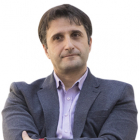




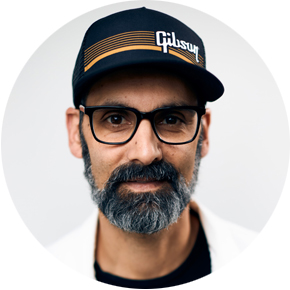

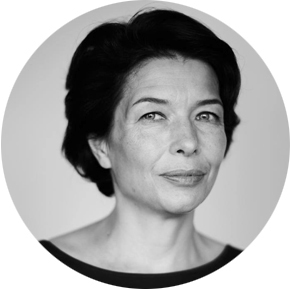





Comments
Dear visitors, You can place your opinion on the material using your Facebook account. Please, be polite and follow our simple rules: you are not allowed to make off - topic comments, place advertisements, use abusive and filthy language. The editorial staff reserves the right to moderate and delete comments in case of breach of the rules.